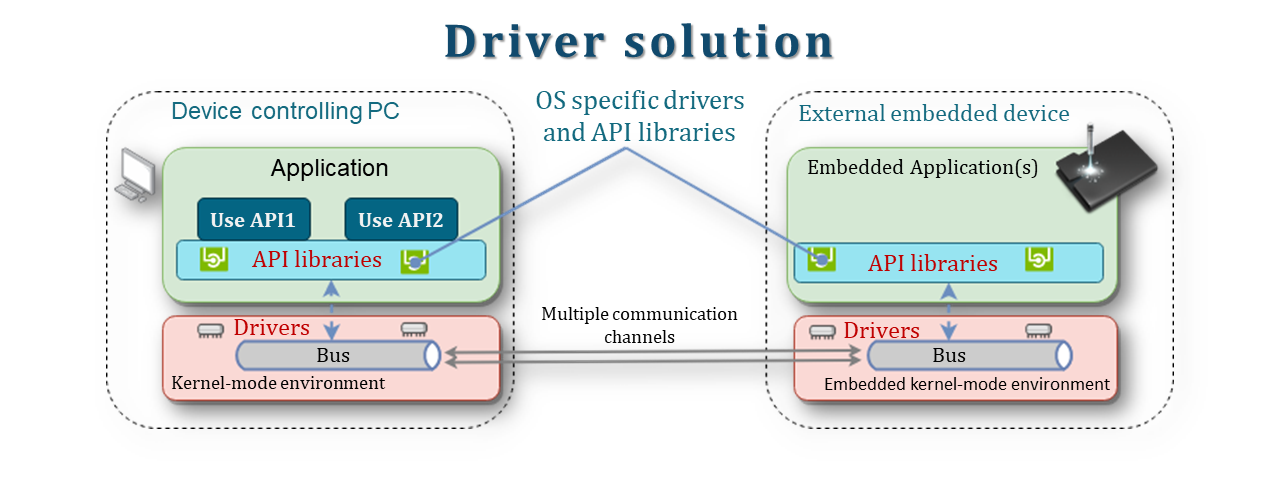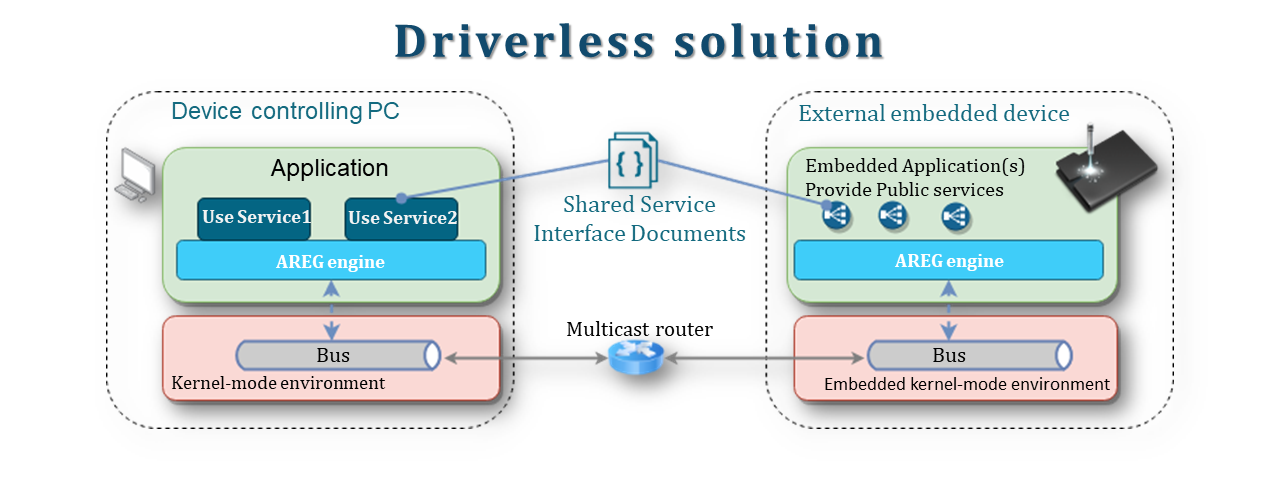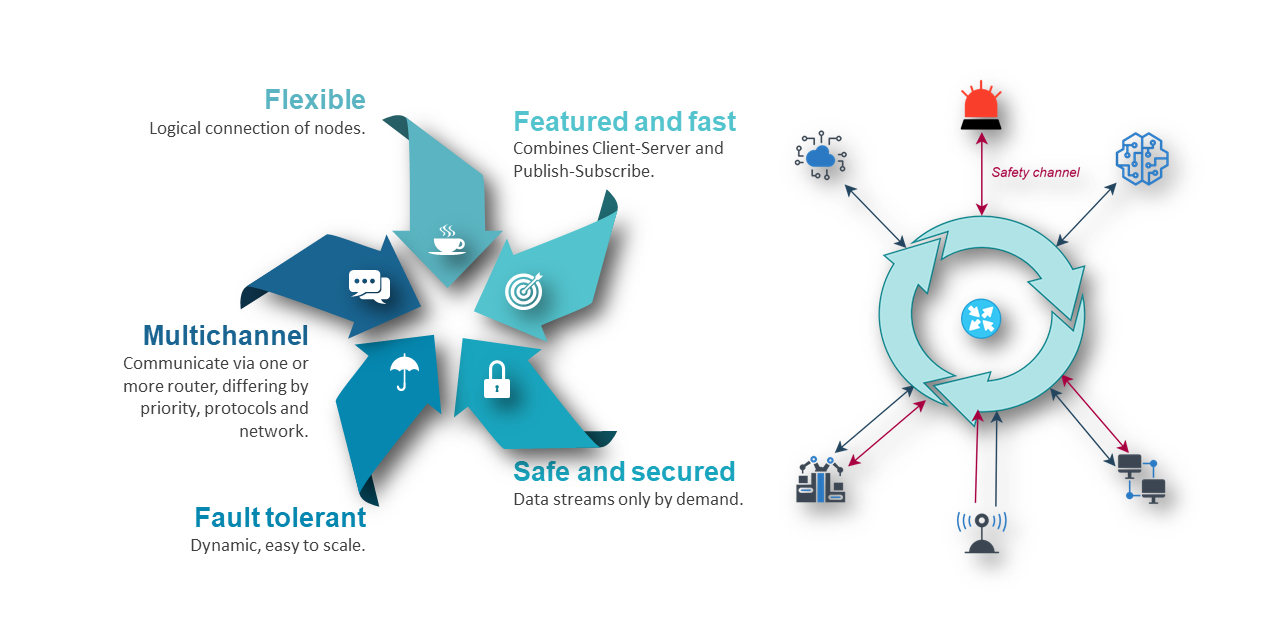AREG (Automated Real-time Event Grid) communication engine can be used in a very large scope of multithreading and multiprocessing application development. This document showcases several examples of how the communication engine can be utilized to develop intelligent devices.
Click to show / hide distributed solution.
The AREG communication engine is a distributed services solution that enables components to interact seamlessly across nodes on the network, appearing as if they are located within a single process. To define relationships and distribute services across processes, developers create runtime loadable models.
The following is a demonstration of 2 models defined in 2 different processes, where one model defines service provider and the second is at the same time is a service consumer (client) and a service provider. For simplicity, let's name them service.cpp and mixed.cpp.
A: model of service provider component in service.cpp:
// service.cpp, define service provider
BEGIN_MODEL("MyModel")
BEGIN_REGISTER_THREAD( "Thread1" )
BEGIN_REGISTER_COMPONENT( "SystemShutdown", SystemShutdownService )
REGISTER_IMPLEMENT_SERVICE( NESystemShutdown::ServiceName, NESystemShutdown::InterfaceVersion )
END_REGISTER_COMPONENT( "SystemShutdown" )
END_REGISTER_THREAD( "Thread1" )
END_MODEL("MyModel")B: model of service consumer and service provider (mixed) component in mixed.cpp:
// mixed.cpp, define service provider and service consumer.
BEGIN_MODEL("MyModel")
BEGIN_REGISTER_THREAD( "Thread1" )
BEGIN_REGISTER_COMPONENT( "RemoteRegistry", RemoteRegistryService )
REGISTER_IMPLEMENT_SERVICE( NERemoteRegistry::ServiceName, NERemoteRegistry::InterfaceVersion )
REGISTER_DEPENDENCY("SystemShutdown")
END_REGISTER_COMPONENT( "RemoteRegistry" )
END_REGISTER_THREAD( "Thread1" )
END_MODEL("MyModel")After declaration of services, each project can load them in the main() method and load them as it is shown in the next example.
C: common code for service.cpp and mixed.cpp files:
int main()
{
Application::initApplication( ); // initialize defaults
Application::loadModel("MyModel"); // load model, start services
Application::waitAppQuit( ); // wait for quit signal
Application::unloadModel("MyModel");// unload model, stop services
Application::releaseApplication(); // release resources
return 0;
}In these codes:
- service.cpp contains model to register service
"SystemShutdown"that implements interfaceNESystemShutdown::ServiceName. - mixed.cpp contains model to register service
"RemoteRegistry"that implements interfaceNERemoteRegistry::ServiceNameand consumes (requires) service"SystemShutdown". int main()is identical in both files. It initializes resources, loads model and waits for the completion.
The developers should create SystemShutdownService and RemoteRegistryService objects that implement the business logic of request methods of provided and response methods of used service interfaces. When these processes start, the services are automatically discovered via mcrouter. With this technique, the projects easily develop multiprocessing applications where provided services can be distributed and accessed remotely within the network formed by mcrouter.
An example of developing a service provider and consumer in one and multiple processes is in Hello Service! guide. As well there are multiple examples of multiprocessing and multithreading applications.
Click to show / hide driverless devices.
Normally, the devices are supplied with the drivers to install in the system.
Proposed are driverless service-enabled devices that do not require installation of drivers in the system.
The services, described in the interface prototype documents, are faster and easier to develop than drivers, as they do not require special techniques and can be developed like user mode applications. Service development reduces risks and the code generator simplifies client object generation from a service interface document.
Click to show / hide real-time solutions.
AREG engine automatically generates and delivers messages to the target and invokes the exact methods of the target objects in real-time with ultra-low networking latency. This makes it ideal for developing time-sensitive applications for industries such as automotive, drone fleets, medtech, real-time manufacturing, and monitoring.
Click to show / hide digital twin.
AREG framework's event-driven and service-oriented architecture, coupled with real-time communication, offers a robust solution for digital twin applications. This framework allows for visualization, monitoring, and control of external devices, while also enabling immediate reaction to changes in the environment or device state. AREG's approach eliminates the need for additional communication layers, making it an ideal solution for emergency, security, and safety applications.
Click to show / hide simulation and tests.
Simulating a software environment is a practical solution for testing and checking rapidly changing software, especially when hardware provisioning is not feasible. Simulations are portable, accessible, and help to optimize solutions while avoiding unnecessary risks. Projects using simulations are better prepared for remote work and easier to outsource.
The distributed and service-oriented solution of AREG engine eases application testing in a simulated environment. For example, the Simulation application may provide identical Data layer services for seamless testing of the rest of the application.
The same technique of simulating data can be used to create API-driven test automations.



